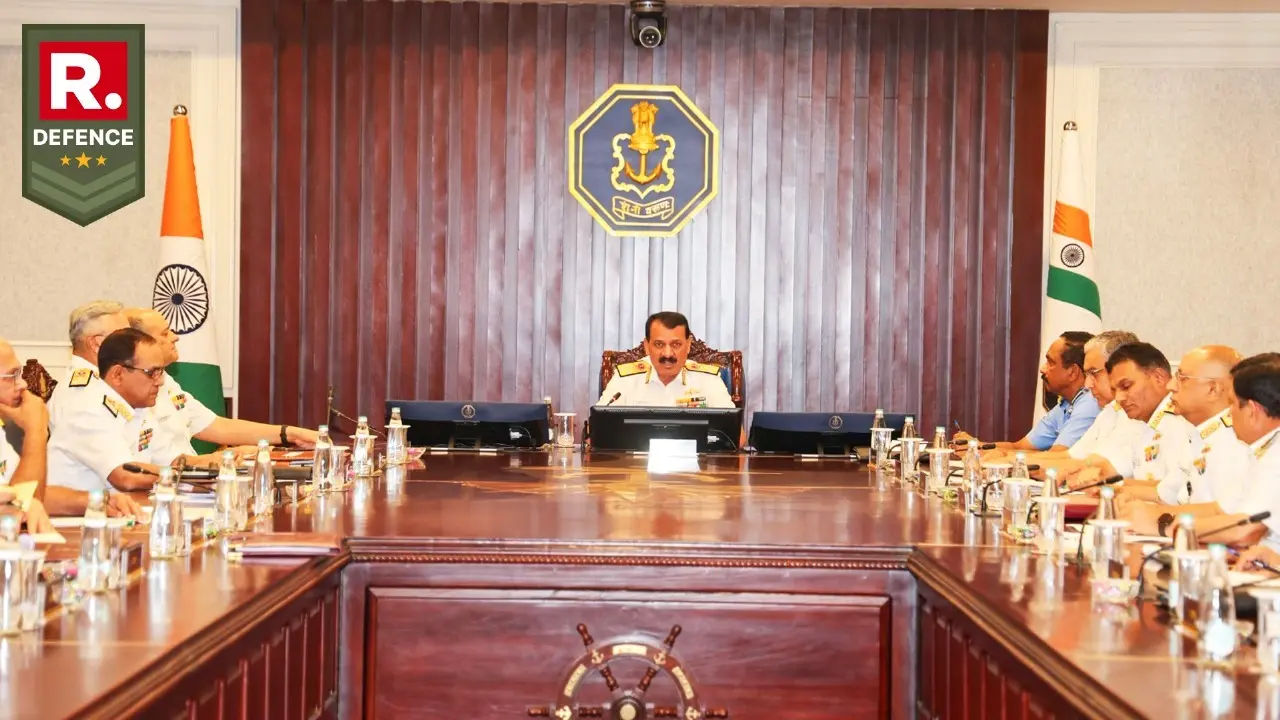Updated 10 April 2025 at 12:46 IST
Indian Navy Chief Charts 7-Point Combat-First Doctrine in Navy’s High-Stakes Strategy Shift
t the 2025 Naval Commanders’ Conference, Admiral Dinesh K Tripathi unveiled a transformative seven-point strategic vision for the Indian Navy.
- Defence News
- 4 min read

New Delhi, India - The Indian Navy is steering into a new strategic era under the stewardship of Admiral Dinesh K Tripathi. As the Naval Commanders’ Conference 2025 winds up in New Delhi following its opening leg in Karwar, Karnataka, the Navy Chief laid out seven strategic priorities aimed at transforming the maritime force into a sharper, tech-integrated and combat-efficient entity. The directives come at a time of shifting geopolitical fault lines in the Indo-Pacific, particularly in the Indian Ocean Region (IOR).
Admiral Tripathi’s agenda zeroes in on the Navy’s core warfighting readiness, urging sustained joint operations with the Indian Army and Air Force. Combat drills and strategic deployment rehearsals are expected to be intensified, reflecting a shift from peacetime posturing to real-time contingency planning. With increased Chinese naval presence in the IOR, this new focus is intended to ensure that the Indian Navy remains not just reactive, but anticipatory in posture.
Force-level Expansion, Tech Adoption, And Fleet Logistics
The second and third focal points—force levels and fleet logistics—are about muscle and stamina. Tripathi called for augmenting India’s naval footprint through indigenous capacity-building, accelerated shipbuilding programs, and platform modernisation. Sustaining high operational availability of the fleet was another critical highlight, with an emphasis on smarter maintenance cycles and leaner logistics chains.

This means cutting down downtime for capital ships and submarines and ensuring that support infrastructure evolves in lockstep with operational requirements. The Chief's message is clear: a platform is only as good as its availability in war or during strategic deployment. He praised the Navy’s recent strides in indigenous shipbuilding and platform reliability, marking a continued shift away from foreign dependence.
Advertisement
Organisational Agility Framed as Pillars of Operational Effectiveness
The fourth and fifth elements address the human core of the Navy—training, talent retention, and responsive leadership. Admiral Tripathi stressed “balanced workforce development” to align with evolving technological roles and command structures. Programs to promote agile decision-making at sea and onshore are expected to be overhauled, making the Navy nimbler in dynamic operational theatres.
Organisational agility was tied closely to geopolitical realities. Tripathi flagged the importance of maintaining operational clarity even under fluid conditions, especially during grey zone maritime confrontations, cyber threats, and hybrid naval warfare. This is not just about speed, but about strategic coherence when surprise scenarios unfold at sea.
Advertisement
Inter-agency Synergy and Geopolitical Foresight
Perhaps the most politically loaded directive was the final one: synergy with national stakeholders. The Navy Chief emphasized working closely with the Ministry of External Affairs, Ministry of Defence, Indian Coast Guard, and intelligence agencies to create a seamless maritime security architecture. This aligns with India’s broader push for a “whole-of-government” approach in asserting dominance in the IOR and building alliances through forums like the QUAD.
Foreign Secretary Vikram Misri, who addressed the gathering, outlined the global shifts in maritime security, touching on the strategic implications of China's assertiveness, supply chain vulnerabilities, and technological race in naval domains. The sessions also saw the release of key publications—ranging from operational data standards to vision documents on space-based maritime support and naval aviation safety.
The conference marks the Indian Navy’s clearest articulation yet of its peacetime-to-wartime transformation doctrine. It sends a firm message—India’s maritime command isn’t just preparing for conflict, it’s preparing for dominance. As Admiral Tripathi concluded, the seas ahead may be turbulent, but with clarity of mission and adaptive leadership, the Indian Navy is set to sail stronger, swifter, and smarter.
Watch- Indian Naval Academy - Asia’s pre-eminent Naval Training Institution
Published By : Yuvraj Tyagi
Published On: 10 April 2025 at 12:46 IST
